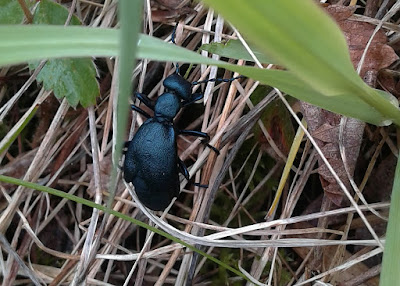A Blister Beetle
My father and I had spent the morning with backs arched downward and eyes darting across the forest floor in search of edible fungi. Like other mushroom pilgrimages of late, the mosquitoes clung on to their summer glory leading us to perspire underneath our otherwise unseasonable outerwear. Our normally observant natures gave way to hasty harvesting as more and more mosquitoes closed in. But in the midst of all those mosquitoes another insect caught my eye--an abdominally plump oil beetle.
I hadn't known at the time that coaxing the shiny blue beetle to walk off its blade of grass and onto my hand was probably not an intelligent decision. But I was curious and admittedly naïve to the ways of oil beetles. The term "oil beetles" is used almost interchangeably with "blister beetles," and the latter is quite the telling family name for over 3,000 species of beetles worldwide. Although the often engorged abdomen might make one think of a blister, the name actually refers to the unpalatable, even toxic, chemical irritant called cantharidin, which these insects promptly secret through joints in their appendages when threatened. Thankfully, my hand was neither threatening enough nor in contact long enough for her to wield her weapon and leave me with painful blisters.
Other animals have better instincts when its comes to oil beetles. While some birds can reportedly withstand the cantharidin in an oil beetle's secretions (which may constitute up to 10% of the beetle by weight), smaller predators don't bother. Oil beetles are thus afforded the leisure of casually perching atop flowers or grass blade without worry of much danger from above.
I only recall encountering one of these powerful beetles on two occasions--once when collecting spring fiddleheads a few years back and again just two weeks ago with Dad. While I don't mean for my personal experience to purport that oil beetles are scarce, it's true that their numbers are in decline in many places. A handy predator deterrent like cantharidin does not mean they can survive all. But what hazards do they have to face? Perhaps their reliance on populations of solitary bees, which are also largely in decline, is part of the culprit. It may also be some other environmental factor, or combination of such, which we must work to understand if we hope to continue encountering these fascinating beetles--from a safe distance of course.
(For more information on oil beetles, check out this interesting piece from off the beaten path!)
Other animals have better instincts when its comes to oil beetles. While some birds can reportedly withstand the cantharidin in an oil beetle's secretions (which may constitute up to 10% of the beetle by weight), smaller predators don't bother. Oil beetles are thus afforded the leisure of casually perching atop flowers or grass blade without worry of much danger from above.
I only recall encountering one of these powerful beetles on two occasions--once when collecting spring fiddleheads a few years back and again just two weeks ago with Dad. While I don't mean for my personal experience to purport that oil beetles are scarce, it's true that their numbers are in decline in many places. A handy predator deterrent like cantharidin does not mean they can survive all. But what hazards do they have to face? Perhaps their reliance on populations of solitary bees, which are also largely in decline, is part of the culprit. It may also be some other environmental factor, or combination of such, which we must work to understand if we hope to continue encountering these fascinating beetles--from a safe distance of course.
(For more information on oil beetles, check out this interesting piece from off the beaten path!)

